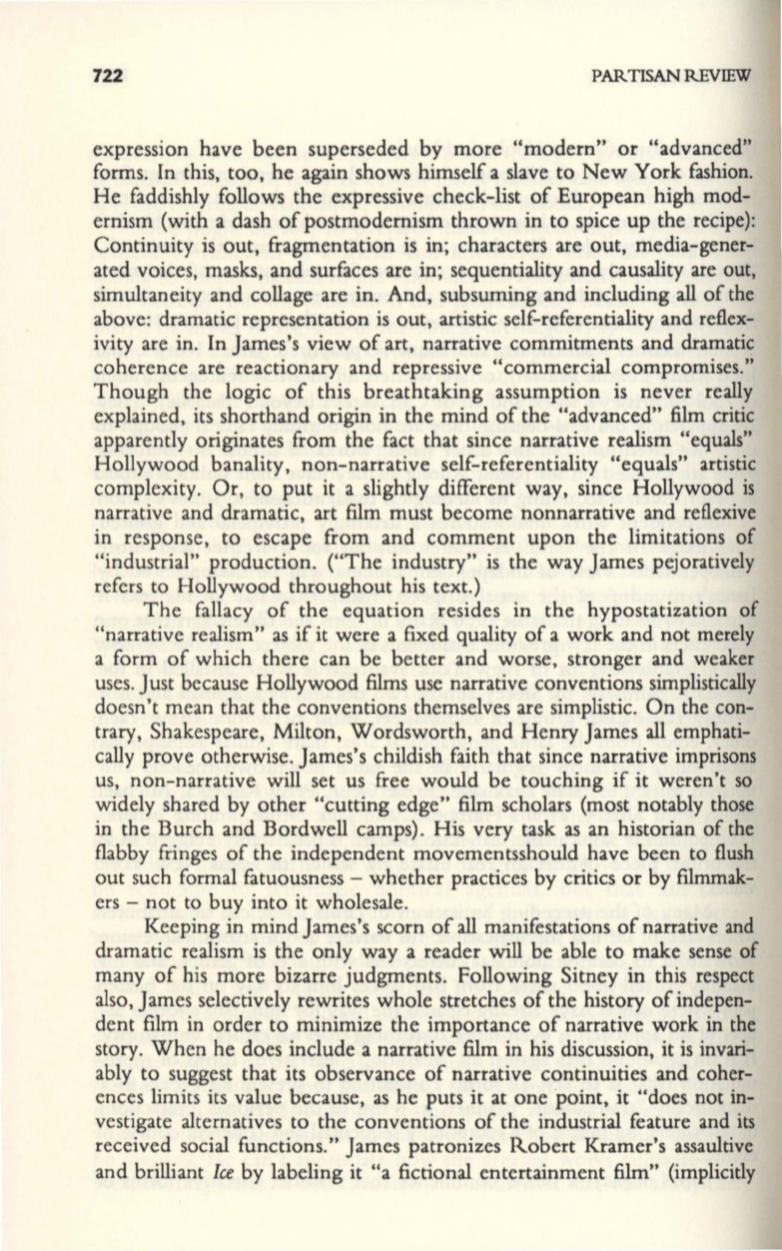
722
PARTISAN REVIEW
expression have been superseded by more "modern" or "advanced"
forms. In this, too, he again shows himself a slave to New York fashion.
He faddishly follows the expressive check-list of European high mod–
ernism (with a dash of postmodernism thrown in to spice up the recipe):
Continuity is out, fragmentation is in; characters are out, media-gener–
ated voices, masks, and surfaces are in; sequentiality and causality are out,
simultaneity and collage are in. And, subsuming and including all of the
above: dramatic representation is out, artistic self-referentiality and reflex–
ivity are in. In James's view of art, narrative commitments and dramatic
coherence are reactionary and repressive "commercial compromises."
Though the logic of this breathtaking assumption is never really
explained, its shorthand origin in the mind of the "advanced"
film
critic
apparently originates from the fact that since narrative realism "equals"
Hollywood banality, non-narrative self-referentiality "equals" artistic
complexity. Or, to put
it
a slightly different way, since Hollywood is
narrative and dramatic, art film must become nonnarrative and reflexive
in response, to escape from and comment upon the limitations of
"industrial" production. ("The industry" is the way James pejoratively
refers to Hollywood throughout his text.)
The fallacy of the equation resides in the hypostatization of
"narrative realism" as if it were a fixed quality of a work and not merely
a form of which there can be better and worse, stronger and weaker
uses. Just because Hollywood films use narrative conventions simplistically
doesn't mean that the conventions themselves are simplistic. On the con–
trary, Shakespeare, Milton, Wordsworth, and Henry James all emphati–
cally prove otherwise. James's childish faith that since narrative imprisons
us, non-narrative will set us free would be touching if it weren't so
widely shared by other "cutting edge"
film
scholars (most notably those
in the Burch and Bordwell camps) . His very task as an historian of the
flabby fringes of the independent movementsshould have been to flush
out such formal fatuousness - whether practices by critics or by
filmmak–
ers - not to buy into it wholesale.
Keeping in mind james's scorn of all manifestations of narrative and
dramatic realism is the only way a reader will be able to make sense of
many of his more bizarre judgments. Following Sitney in this respect
also, James selectively rewrites whole stretches of the history of indepen–
dent film in order to minimize the importance of narrative work in the
story. When he does include a narrative film in his discussion, it is invari–
ably to suggest that its observance of narrative continuities and coher–
ences limits its value because, as he puts it at one point, it "does not
in–
vestigate alternatives to the conventions of the industrial feature and its
received social functions." James patronizes Robert Kramer's assaultive
and brilliant
Ice
by labeling it "a fictional entertainment
film"
(implicidy


